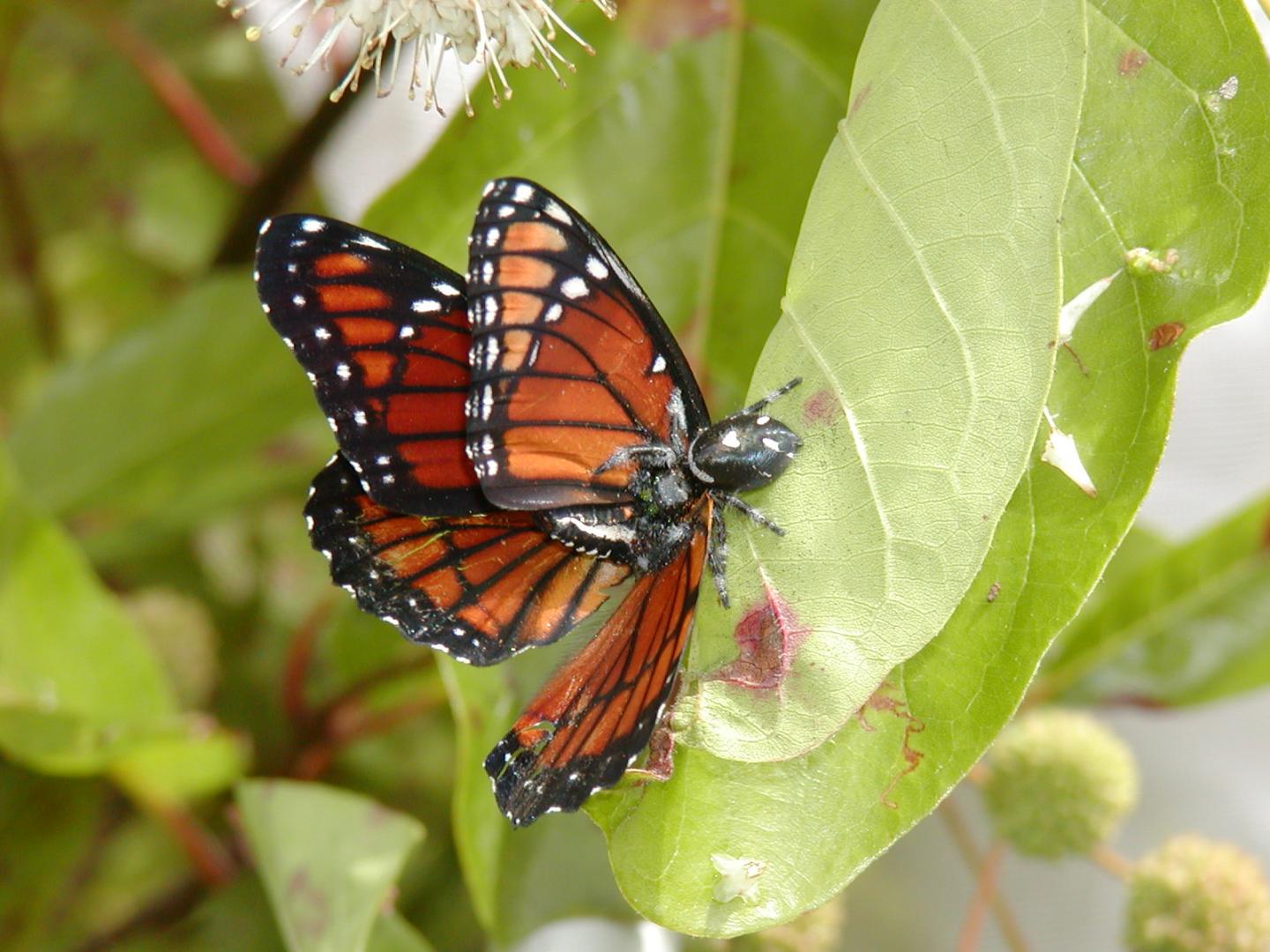
Credit: Photo: Katy Prudic/University of Arizona
The viceroy butterfly is a mimic, modeling its orange-and-black colors after the queen butterfly, a bug that tastes so disgusting predators have learned not to eat it or anything that looks like it, including viceroys. The apparent dependence of mimics on their models made biologists wonder if the fates of the two species are forever intertwined. If so, then what happens when the mimic and the model part ways?
A study recently published in Communications Biology and led by Katy Prudic, an assistant professor in the College of Agriculture and Life Sciences at the University of Arizona, has found an interesting answer. Viceroy butterflies living in northern Florida, far away from the southern-dwelling queen butterflies, are not only more abundant than their southern kin, but they have also developed their own foul flavor.
“In classical mimicry theory, we wouldn’t predict that the viceroy butterfly would be able to stay or be in northern Florida. It should be limited to southern Florida, where the queens live,” Prudic said.
The classical theory, called Batesian mimicry, posits that one animal, known as the mimic, looks like another animal – the model that predators recognize as “unpalatable.” An unpleasant experience trying to munch on the model species convinces predators to avoid both species, since they cannot reliably tell the difference between the two.
If the butterflies followed Batesian mimicry, populations of viceroys living in regions where predators had never met the unpalatable queens would not recognize the orange color of the butterfly as something awful; it would look like a delicious, easy-to-find snack, and predators would pick off the viceroy.
Yet Prudic’s study found that the viceroy thrives where the queen is not found, because it has evolved the ability to taste bad.
“Have you ever chewed aspirin?” Prudic said. “It will not kill you, but you may want to die because it will be really, really unpleasant.”
Prudic’s study began more than 15 years ago, as part of her doctoral dissertation. Prudic and her co-author, UA data science specialist Jeff Oliver, counted viceroy and queen butterflies and their host plants at eight sites across Florida.
All over Florida, the viceroy caterpillar feeds on the same kind of plant: the Carolina willow. The tree arms itself against pests with phenolic glycosides, chemical relatives of aspirin.
To pests, the aspirin-related toxins may be deadly, but caterpillars have evolved ways to avoid being poisoned by the plants. By possibly storing them in fatty bodies, viceroy caterpillars keep the chemicals out of their metabolic processes, and they live unharmed.
When the viceroy lives alongside its model species, it likely discards the toxins when it metamorphoses from caterpillar to butterfly. But Prudic and her team found that when the mimic lives independently from the queen butterfly, it keeps the toxins, making the viceroy unpalatable to predators.
In a pharmacology lab, UA Regents’ Professor Barbara Timmerman helped Prudic investigate how much of the aspirin-related chemical could be found in the viceroy butterflies. These results were then compared to the abundance of queens at the capture sites.
The second experiment was to test the viceroys’ chemical defenses against predators. The butterflies were fed to praying mantids that had been hand-reared in the lab, and Prudic studied how they reacted to the butterflies. The mantids had a much stronger response to viceroys originating from those places where there were not any queens.
“They learned to avoid these viceroys faster, and remembered to avoid them for longer,” Prudic said.
Years of rigorous statistical analysis followed, so that Prudic and her team could be certain about the relationship between the unpalatability of viceroy butterflies and the abundance of queen butterflies.
A mimicry continuum
This discovery changes the way biologists must think about mimicry.
The relationship between viceroy and queen butterflies once fell into the Batesian mimicry category, but when one of Prudic’s co-authors, David Ritland, first discovered that viceroys had the ability to be nasty, the butterflies’ relationship was recategorized as “Mullerian.” There are no models in this mimicry theory, only “co-mimics:” two different animals that look the same and are both unpalatable.
But Prudic’s study proves that the viceroy butterfly does not fit neatly into either mimicry category.
“Both these categories that we thought about in mimicry are now coming together, and we are thinking more about a continuum between Batesian and Mullerian,” Prudic said.
She expects that such a continuum is not limited to just the viceroy-queen system; however, studies that deeply investigate mimicry relationships are unusual because they are time-consuming, labor-intensive and difficult to execute.
Aside from proving that mimicry in the animal world cannot be sorted into a simple binary, this study may be helpful for conservation and management of species in the changing world.
“It gives us predictive power to understand where critters will be, that they are not restrained to just where their models are.”
###
Media Contact
Daniel Stolte
[email protected]
520-626-4402
Original Source
http://uanews.
Related Journal Article
http://dx.




